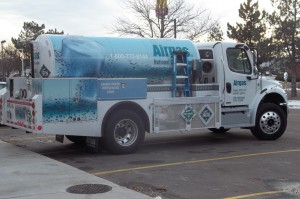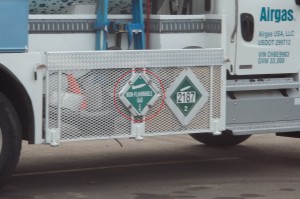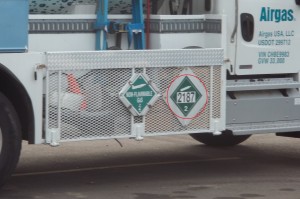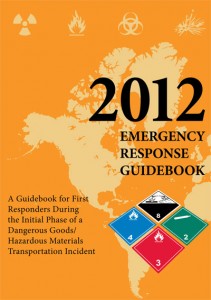Hazardous materials are a common fixture in our modern lives and an essential ingredient in many of things we take for granted; like drinking carbonated soda from the fountain at our favorite restaurants. Well, the HazMat has to get to the restaurant somehow and that’s where its transportation in commerce becomes necessary. Now, we all want the transportation of hazardous materials on our highways and in our neighborhoods to be safe, so that’s why we have the Hazardous Material Regulations of the PHMSA/USDOT. One way the HMR ensures the safe transportation of hazardous materials in commerce is by requiring the use of the four hazard communication methods:
- HazMat Labels
- Markings
- Shipping Papers
- Placards
In this article I’ll take an example of HazMat transportation selected right from daily life and use the hazard communication methods (those I have available to me) to discern just what the HazMat is and what its potential hazards are.
- The Placards, visible on all four sides of the vehicle,identify the HazMat as a Class 2/Division 2.2 Non-Flammable Gas.
- In this case the Carrier used two placards; one of which is used to indicated the identification number Marking (more on that below). Interestingly – at least to a HazMat geek like me – the placard on the left is not necessary but its presence does not detract from the communication of the potential hazards of the materials so it is not a violation.
- The four digit identification number Marking, also visible on all four sides of the vehicle, identify the hazardous material specifically as carbon dioxide, refrigerated liquid. How? Search for 2187 in column 4 of the Hazardous Materials Table at 49 CFR 172.101 and you’ll find the identification number UN2187 belongs to only one entry: Carbon dioxide, refrigerated liquid.
- Want some confirmation? As required by 49 CFR 172.328(b)(1), this cargo tank of a Class 2 material is marked on each side and each end with its proper shipping name (found in column 2 of the Hazardous Materials Table). In this case: Carbon Dioxide Refrigerated Liquid.
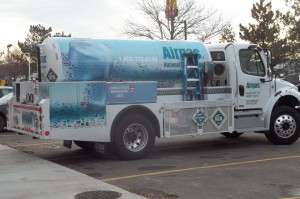
A cargo tank motor vehicle of a compressed gas must be marked with the proper shipping name or an appropriate common name for the HazMat.
Is any of this information helpful in an emergency? Yes it is. In an emergency involving this hazardous material, the two hazard communication methods provide on the vehicle: Identification Number and Proper Shipping Name may be used to determine the appropriate emergency response procedures. How?:
- Refer to the yellow pages of the 2012 Emergency Response Guidebook and look for the 4-digit identification number; 2187.
Or…
- Refer to the blue pages of the 2012 ERG and look for the proper shipping name; Carbon dioxide, refrigerated liquid.
Either way, you’re going to find a reference to Guide Number 120. Now refer to Guide Number 120 in the orange pages of the 2012 ERG, and there you will find information necessary for the initial stages of an appropriate response to an incident involving this HazMat; a summary of which follows:
- Its Potential Hazards to Health: “Vapors may cause dizziness or asphyxiation without warning”
- Its Potential Hazards for Fire or Explosion: “Non-flammable gas“
- Public Safety concerns:
- “As an immediate precautionary measure, isolate spill or leak area for at least 100 meters (330 feet) in all directions.”
- “Wear positive pressure self-contained breathing apparatus (SCBA).”
- “Consider initial downwind evacuation for at least 100 meter (330 feet).” if a Large Spill.
- Emergency Response in the event of a Fire: “Use extinguishing agent suitable for type of surrounding fire.”
- Emergency Response in the event of a Spill or Leak: “Do not touch or walk thorough spilled material.”
- Emergency Response if First Aid is required: “Move victim to fresh air.”
There’s even more information available on the vehicle if you know where to look. The passenger – and driver side – door of the vehicle includes the following information about the Carrier of the HazMat:
- Name of the Carrier: Airgas USA, LLC.
- Carrier’s USDOT Number: 299712. A search for this number in the database of the Federal Motor Carrier Safety Administration (another Administration within the USDOT) provides the Carrier’s Company Safety Profile.
- The Vehicle Identification Number (VIN) for the truck: CHBE9983.
- The Gross Vehicle Weight (GVW) in pounds of the truck: 33,000. Due to its weight of greater than 26,000 lbs and the fact that it transports a quantity of HazMat that requires placarding, the truck is a Commercial Motor Vehicle and therefore its driver and the Motor Carrier are subject to the regulations of the FMCSA regarding the Commercial Driver’s License (CDL), hours of service, vehicle inspections, &etc.
The information is there, if you know where to look. Contact me if you have any questions about the transportation of hazardous materials or require HazMat Employee training.
|
Contact me with any questions you may have about the transportation of hazardous materials by air, highway, vessel, or rail International and Domestic Daniels Training Services 815.821.1550 |
